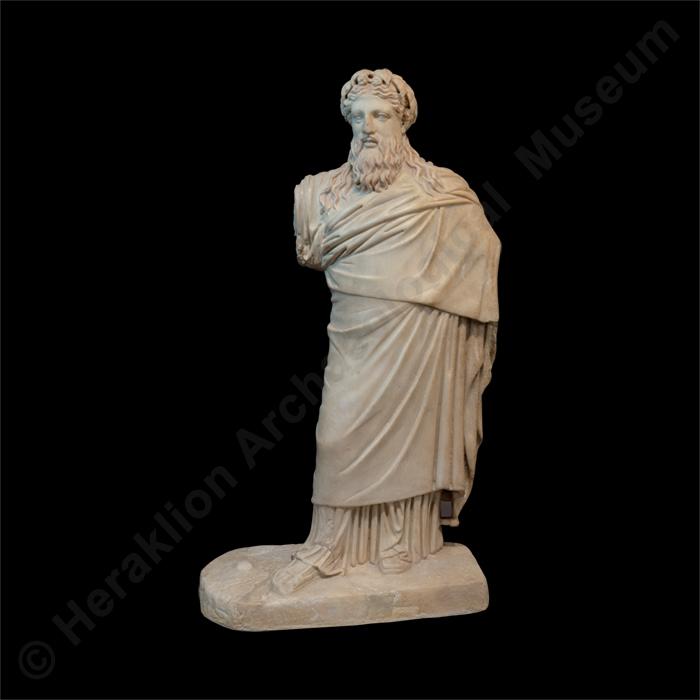Marble statuette in the Dionysus-Sardanapalus type
Γ315
Stone (White marble)
Almost intact. Missing the extended right hand and thyrsus it held. The right leg and underlying integral base are mended and partly restored.
Height: 66 cm. Width: 25 cm. Thickness: 5 cm.
Knossos
Environs of the Villa Ariadne
Roman period:
117-138 AD:
Gallery:
XXVIICase:
Not in caseExhibition thematic unit:
Sculpture. Hellenistic period (3rd-2nd c. BC) Roman period (1st c. BC-3rd c. AD)Statues of gods
Description
Statuette of the so-called “Dionysus Sardanapalus” type which adorned a Roman villa. The god is depicted standing in a relaxed pose, turning to the right with the right leg slightly forward, and supporting himself with his now lost right hand on a thyrsus, the lower end of which is just visible on the base of the statuette. He is crowned with a wreath of ivy leaves and berries, while the existence of added metal elements is indicated by the holes in his hair and ears. He has a long beard and hair, partly pulled into a bun (crobylus) at the back of the head. He is wearing a long, sleeved chiton (tunic) under the heavier himation (cloak), which is draped around his body covering one arm and falls over the left shoulder in heavy pleats. The contrast between the drapery of the two different-textured garments would have been heightened by the use of different-coloured paint for each. The feet are sandalled. Careful polishing is only preserved in places on the face and himation, with traces of reddish-brown paint on the hair and beard. Despite its small size, the statuette is a good-quality copy of the original bronze statue (330-320 BC), attributed to the school of Praxiteles.Bibliography:
B. Ashmole, "The so-called "Sardanapalus", The Annual of the British School at Athens 24 (1919-1921), 84-85, fig. 4-5. L. Curtius, "Sardanapal", Jahrbuch des Deutschen Archäologischen Instituts 43(1928), 281-297. G. Lippold, Die Skulpturen des Vaticanischen Museums, III, Berlin 1956, 61-65, no. 608, pl. 30-31. Platon N., A Guide to the Archaeological Museum of Herakleion, Athens, 1964, 152., S. Alexiou, Οδηγός Αρχαιολογικού Μουσείου Ηρακλείου, Athens 1968, 133, pl. 30b. E. Pochmarski, "Neue Beobachtungen zum Typus Sardanapal", Jahresheft des ӧsterrreichischen ArchäologischenInstituts in Wien 50 (1972-1975), 59-60, no. 10. For the type see Lexicon Iconographicum Mythologiae Classicae III (1986) 431ff. no. 89, s.v. Dionysos (C. Gasparri). N. Dimopoulou-Rethemiotaki, Το Αρχαιολογικό Μουσείο Ηρακλείου, Athens 2005, 389. A. Pasquier - J.-L. Martinez, Praxitèle, Musée du Louvre 23.5.-18.6.2007, 328-330, no. 81 (J.-L. Martinez). Ν. Katsas - G. Despinis (eds), Πραξιτέλης, Εθνικό Αρχαιολογικό Μουσείο, 25.7.-31.10.2007), Athens 2007, 168-169 (G. Mostratos). K. Sporn, "'The Cretan Venus'. Überlegungen zur Skulpturenausstattung von römischen Privathäusern auf Kreta", in P. Karanastasi et alii (eds), Γλυπτική και κοινωνία στη ρωμαϊκή Ελλάδα: καλλιτεχνικά προϊόντα, κοινωνικές προβολές, Διεθνές συνέδριο Ρέθυμνο, 26-28 Σεπτεμβρίου 2014, Thessaloniki 2018, 278, pl. 7. P. Karanastasis, "Roman imperial sculpture from Crete: a reappraisal", in J.E. Francis - A. Kouremenos, Roman Crete: New Perspectives, Oxford 2016, 104-105, figs 8.4-8.5.Author:
K. S.Photographs' metadata
